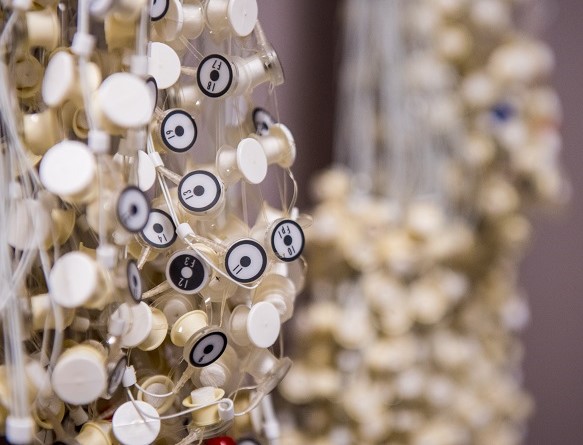Cognitive Neuroscience Core
The Cognitive Neuroscience (CN) Core provides CNAP researchers with access to critical tools and resources needed for cognitive neuroscience research. The Core began as a dedicated multi-user research facility that was established in 2019. At that time, the Core featured resources and equipment for research utilizing electroencephalography (EEG) techniques, but our Phase 2 COBRE award will allow us to add newcapabilities and infrastructure for transcranial magnetic stimulation (TMS) and repetitive TMS (rTMS) research. Located within the Department of Psychological Sciences, it is the only COBRE-funded Cognitive Neuroscience/EEG Core in the state of Kansas, providing resources, equipment, and technical support to enhance the research capabilities of CNAP primary projects and programs.
Facilities and Equipment
The CN Core has three EEG systems available to users.
Bio Semi
The BioSemi ActiveTwo system is equipped with up to 104 channels, a DC amplifier and 24-bit resolution. Our BioSemi ActiveTwo system uses electrode gel (SignaGel) and three cap sizes for reliable measurement. It also includes individual leads/connectors to capture facial and muscle activity. The ActiveTwo system is compatible with MEG/MCG and suitable for EEG, electrocardiogram (ECG) as well as electromyography (EMG) measurements. The ActiveTwo is battery powered with high-speed fiber optic data transfer, which makes the subject fully optically and galvanically isolated from any mains. The BioSemi ActiveTwo system is specifically designed to be used in research applications only. The system is freely configurable hardware and completely open-source software.
OpenBCI Mobile/Wireless EEG Systems
Our OpenBCI mobile system offers three (small, medium, and large) EEG Electrode Caps, each with their own Cyton + Daisy Biosensing Boards (16-Channels). The OpenBCI Cyton Board and OpenBCI Daisy Module (which plugs into the OpenBCI Cyton Board) can be used to sample up to 16 channels of brain activity (EEG), muscle activity (EMG), and heart activity (ECG). The system communicates wirelessly to a computer via the OpenBCI USB dongle using RFDuino radio modules. It can also communicate wirelessly to any mobile device or tablet compatible with Bluetooth Low Energy (BLE). The CytonDaisy Board samples data at 125 Hz on each of its 16 channels. The OpenBCI software can be used in conjunction with Matlab, Neuromore, OpenViBE, Lab Streaming Layer (LSL), BrainBay, and BioEra. OpenBCI data can be analyzed using EEGLAB, FieldTrip, and ERPLAB.
MagStim/Electrical Geodesic Inc. (EGI)

This system offers six 64-channel Geodesic Sensor Nets (GSN) in three sizes with whole-head coverage evenly spaced over the entire scalp, cheeks, and back of neck. Our system includes Net Amps 300 series of amplifiers with Net Station 5 suite of software for EEG acquisition, review, and analysis. Net Station software saves data files in Metafile Format (MFF), which can be exported to the EDF+ format, MATLAB, EEGLAB, FieldTrip, or your own custom software. The GSN works for standard one-to-two-hour experiments. Application time for the sponge-based hydrocel GSN can take only fifteen minutes, with a simple saline solution.
Phase 2 upgrades will include the addition of transcranial magnetic stimulation (TMS) and repetitive TMS (rTMS) equipment to the Core. These research modalities, when coupled with EEG, will add an important causal component to our existing research capabilities, enabling explicit testing of the causal role of specific brain areas in cognitive processes.
Core Services
The CN Core not only provides access to research facilities, and equipment, but also provides researchers with valuable resources and support for conducting their EEG-based research projects. The Core staff are available to assist with the following activities:
- Providing input for study design, collection, and analyses
- Providing data support for planned studies, including data collection, programming, and experiment session troubleshooting when problems arise
- Assisting with customized scripts for data importing, cleaning, and analyses
- Ensuring that requirements for an experiment are met prior to full data collection (e.g., IRB approval letter, test running programs, timing tests for stimuli, and speaking to program support to resolve any issues in EEG and/or computer equipment)
When the TMS/rTMS capabilities are online, the Core will provide additional services related to those technologies.
Staff
Core Advisors
Senior advisor: Dr. Lester Loschky is a professor of Cognitive Psychology. He is an expert in visual cognition (how seeing affects thinking, and how thinking affects seeing) and specializes in studying eye movements and attention. He has been actively involved in the development of the CN Core since its inception and advises on Core management and research development.
Scientific advisor: Dr. Julio C Hernandez-Pavon is an assistant professor of human neuroscience, brain stimulation, neuroimaging, and signal analysis processing in the Department of Psychological Sciences at K-State. He is an expert in transcranial magnetic stimulation (TMS) combined with electroencephalography (EEG). His research includes understanding the underlying mechanisms of human brain connectivity and developing new approaches to induce neuroplasticity for basic and clinical research. He is also interested in motor and language disorders and developing new therapies for post-stroke patients and patients with Parkinson’s disease.
Contact
Interested researchers can email cnap@ksu.edu to learn more about the CN Core facilities and services or to schedule a tour.